Bologna is a city in central Italy known for its delicious cuisine and is home to the oldest university in the world that is still in operation. Also, it has a history closely intertwined with that of the Papal States, of which it was a part. Due to its convenient location and excellent transportation links to major Italian cities, Bologna makes for the perfect day trip destination. Visitors can explore the city’s medieval towers, fountains, places of worship, historical palaces, and 40-kilometre-long porticoes.
Table of Contents
Explore the charm of Bologna’s historic center
Bologna is a university city known for its rich cultural heritage and artistic events. Beautiful hills surround it, and it is famous for its delicious cuisine, including ragù and tortellini. The city’s historical centre houses some of its main attractions, which are easily accessible on foot. To get the most out of the city, you can take a City Center Walking Tour to explore Bologna’s best sights.
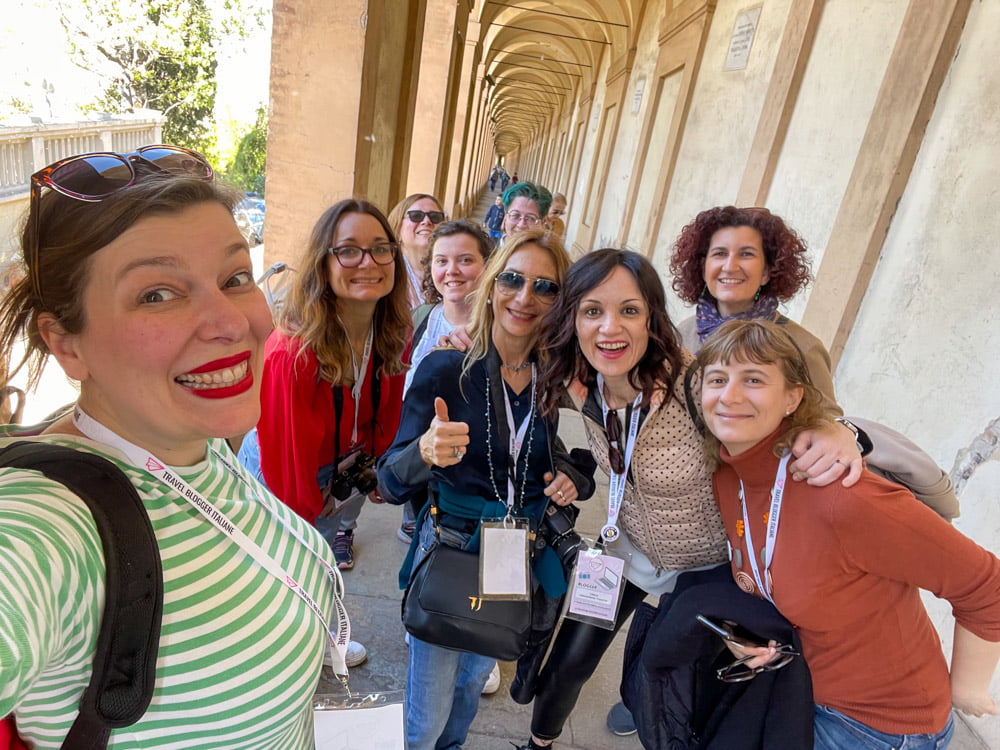
PLAN YOUR TRIP TO ITALY
Stay connected on the go with a Holafly eSIM, offering unlimited data at reliable 3G, 4G, and LTE speeds across Italy.
For added peace of mind during your travels, take out Heymondo travel insurance, perfect for a stress-free and well-protected adventure.
If you plan to explore beyond the main cities, renting a car is the best way to discover Italy’s hidden gems at your own pace.
Piazza Maggiore
The heart of Bologna, where any visit to the city should begin, is Piazza Maggiore. It’s a square for markets and popular assemblies since the Middle Ages. This is why you can see on a wall in the square the different units of measurement for trade used in Bologna before the introduction of the metric system. In the Middle Ages, each city used its own measurements. Bologna used tile and brick for buildings, the foot for distances and the arm or half-arm for cloth.
Piazza Maggiore also has a statue of Pope Gregory XIII, the pope who reformed the calendar as we know it today. Pope Gregory XIII was a prominent figure in the city. Once he ascended to the papal throne, he commissioned the creation of the Sala delle Carte Geografiche in the Vatican Museums, a series of maps of Italy oriented from the point of view of Bologna.
When visiting Piazza Maggiore, you should remember that two of the city’s most important guilds had headquarters in the Middle Ages. That of the butchers, hence the saying ‘Bologna la grassa’ (Bologna the fat). While that of the notaries is remembered as ‘Bologna la dotta’ (Bologna the learned). The notaries’ guild also had a chapel in the square.
The historical buildings of Piazza Maggiore
Some of Bologna’s most important historical buildings are around and in the centre of Piazza Maggiore. Some examples are the Palazzo Comunale, the Palazzo del Podestà, the Palazzo di Re Enzo, the Palazzo dei Bianchi and the Neptune Fountain. An all-Bolognese curiosity is that the Re Enzo Tower has no foundations. It stands on pillars above the voltone del Podestà.
The portico of Piazza Maggiore itself is one of the bizarre things to discover in Bologna. The four corners of the portico transmit sound to the opposite corner. One of the activities to do in the city with friends is to whisper something in one corner, while another listens from the opposite corner.
The Torre dell’Orologio, which houses the Municipal Art Collections, only rings on the 21st of April to remember the Liberation. In Bologna, it happened earlier than in the rest of Italy. However, it is not a public holiday. Even in Bologna, the Liberation is celebrated on 25 April like the rest of Italy. The ringing of bells remains a much-loved tradition in the city.
Neptune Fountain
Bologna was part of the Papal States. Hence, the Neptune Fountain, built at the behest of Pope Pius IV and one of the city’s symbols. Created by sculptor Giambologna in 1564, the fountain is supplied by an underground cistern two kilometres away. Despite its beauty, the Neptune Fountain was fenced off for centuries. In the past, it was also used to wash vegetables in the Piazza Maggiore market.
The statue of the god Neptune represents the exaltation of papal power. At his feet are the figures of the Nereids, sirens with two tails, representing the continents. The allegory concerns the Church’s authority over the world and the ambition of the popes ruling Bologna.
The god Neptune is sculpted in a mannerist manner, with a twisting of the torso that shows off the body’s muscles. The god’s physique remains attractive even by contemporary standards of beauty. Yet, another anatomical detail is noticeable when observing the statue from a specific point on Piazza Maggiore.
Looking at the fountain from the so-called ‘stone of shame’, in Italian pietra della vergogna, marked by a different colour, the god’s left hand appears an erect phallus. It is an anatomical oddity not intended by the sculptor Gianbologna. Despite this, today, one of the reasons to admire the imposing bronze statue literally from every angle.
Finally, another of the secrets of the Neptune statue is its trident. This inspired the Maserati carmaker’s logo. The Maserati logo and the trident of the god Neptune are the same. Anyway, no Bolognese seems to have ever resented the plagiarism.
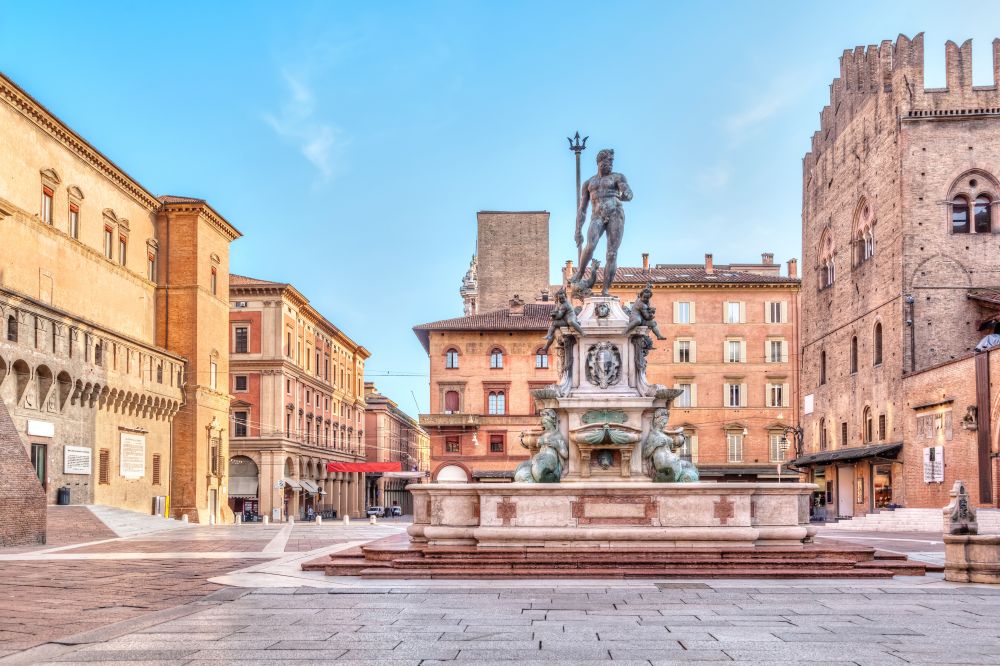
Palace of the Podesta
The Palazzo del Podestà is a historical building located in the centre of Piazza Maggiore, near the Neptune fountain. It was the first seat of the city government. Built at the beginning of the 13th century, the building initially housed podestà, judges and officials. Although it has performed various functions over the centuries.
Today, you can only visit the Palazzo del Podestà during exhibitions and special events. Still, it remains a must-see attraction in Bologna because it is closely linked to its history.
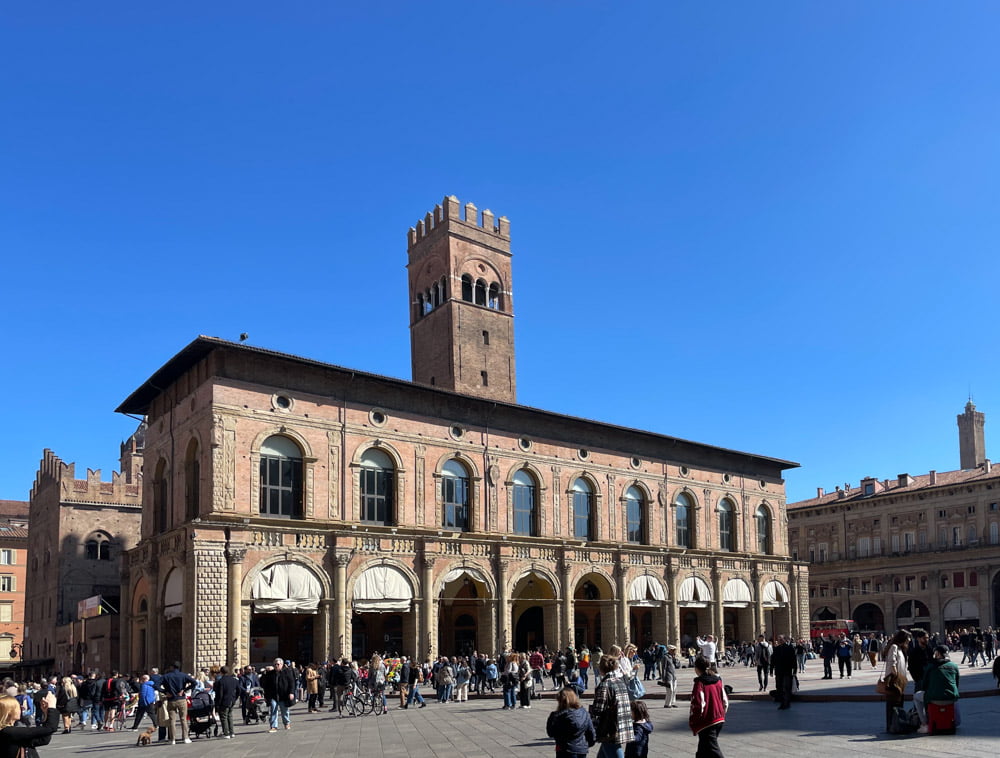
Palace of King Enzo
The Palazzo Re Enzo, located next to the Palazzo del Podestà, was built between 1244 and 1246 as an extension of the municipal buildings. It is named after King Enzo, son of Frederick II, who was imprisoned there for 23 years until his death. Today, Palazzo Re Enzo is a venue for congresses, exhibitions, cultural initiatives and business meetings.
From sources of the time, King Enzo is described as a handsome, medium-sized man with a generous heart and great charm. Gifted with a brilliant mind, bold, cultured and inclined to the arts, like his father, Frederick II, he loved to compose songs and sonnets in the Sicilian vernacular and was fluent in Latin, German and Provençal.
Between 1239 and 1249, he took part in the conflict between the Empire, the communes and the papacy in Italy alongside his father. However, on 26 May 1249, during a battle near Fossalta, in the province of Modena, King Enzo was captured by troops of the Guelph commune of Bologna.
Frederick II tried everything to get his son freed, including rich ransom offers and letters. Unfortunately, the proud Bolognese decided to keep King Enzo a prisoner until the end of his days.
The captivity of King Enzo
The imprisonment was harsh at first. As the years went by, it became less so, bordering on semi-freedom. He had servants and pages at his service and was entitled to receive visitors, including women by whom he had children. King Enzo stayed in the palace for the rest of his life.
At least once, King Enzo attempted to escape by hiding in a brenta, a sizeable upright basket for carrying bread. However, he was discovered because of a blond lock of hair sticking out of the basket. The escape scene is depicted on a terracotta tile on the outside wall of the Palazzo del Podestà. It is one of the curiosities of Bologna to look for during a visit to Piazza Maggiore.
Basilica of Saint Petronius
The Basilica of St Petronius, located in Piazza Maggiore, is Bologna’s most iconic building and a significant tourist attraction. First, the Basilica, although the most famous church in the city, is not the cathedral of Bologna. The church is dedicated to St Petronius, the eighth bishop of Bologna.
The construction of the Basilica of St Petronius dates back to the 14th century. It was not until 1514 that the architect Arduino degli Arriguzzi was commissioned to complete it. Initially, the project envisaged a size surpassing St Peter’s Basilica in Rome. Work was interrupted by Pope Pius IV, probably so as not to obscure the importance of the Roman church. Despite this, the Basilica of St Petronius remains the largest brick Gothic church in the world, and the sixth-largest basilica in Europe.
Inside the Basilica are two unique attractions: the longest sundial in the world and the oldest working organ in Italy. Notably, the organ is equipped with an independent register, which means you can select which row of pipes to play. In addition, the interior of the Basilica houses 22 chapels that open into the aisles and preserve works of art of great beauty.
The unfinished façade of the Basilica of St Petronius is one of its distinctive features. In the 16th century, numerous variations were studied to complete it. However, work was interrupted each time due to a lack of funding and rants over the style to be adopted. The unfinished façade has, therefore, in its way, become a unique work of art, testifying to the variety of projects that were drawn up to complete it.
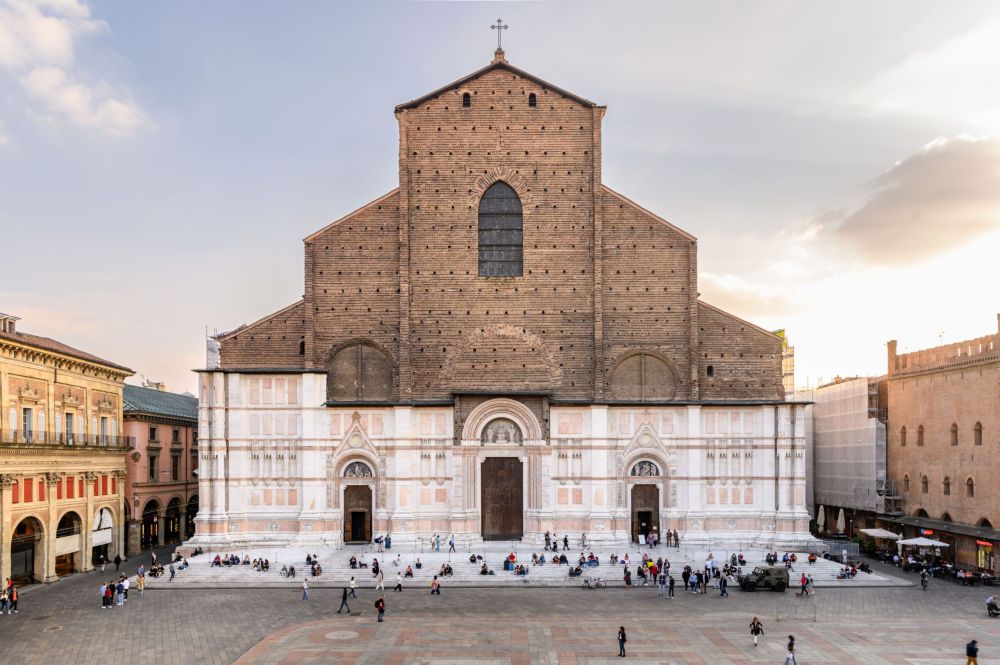
Basilica of St Stephen
The Sanctuary of St Stephen is one of the most important churches in Bologna. It is located in the square with the same name. Its origin dates back to the 5th century when Bishop Petronius wanted to recreate a copy of the Holy Sepulchre in Jerusalem after a trip to the Holy Land. Just as happened with the Sacred Mounts in northern Italy.
The St Stephen’s Basilica stands on the site of an ancient pagan temple dedicated to the Egyptian goddess Isis. Over the centuries, it has undergone many modifications and extensions. The St Stephen’s Basilica is part of the larger complex of the Seven Churches, seven churches located one inside the other.
Inside the sanctuary is an octagonal baptistery, symbolising eternal life. Its octagonal shape, with eight sides, represents the eight days of waiting for the resurrection. For the Christian religion, the first seven days are those in which the world was created. Other artistic and architectural marvels include the Lamentation over the Dead Christ sculpture from the 1700s and the Romanesque style Cortile di Pilato from Emilia.
If you are curious about the history of this complex, you can visit the St Stephen’s Museum. The museum houses cultic objects, shrines, cassocks and works of art once displayed in the Seven Churches. Admission to the Basilica Sanctuary of St. Stephen is free during opening hours. It is, therefore, worth looking at its exceptional interior, which is different from other churches in Bologna.
Bologna Walk of Fame
Only some know that Bologna is home to Italy’s only jazz Walk of Fame. It is located in Via degli Orefici between Piazza Maggiore and the Two Towers. The walk celebrates the great names of world jazz music through stars placed on the pavement.
The association La Strada del Jazz annually places a marble star with golden contours on the pavement. Stars are dedicated to the great international artists who participate in the Bolognese music event of the same name. Among the most famous stars are those devoted to Miles Davis, Ella Fitzgerald and Duke Ellington. The biggest star in the middle of the street is dedicated to Lucio Dalla. He was one of the most famous Bolognese singer-songwriters.
Lucio Dalla began his career as a clarinet player in the Dr. Dixie Jazz Band, founded by Nardo Giardina in 1952. The group is still active today and is considered the longest-running jazz band in the world. It was in this group that Lucio Dalla met director Pupi Avati. It is said that relations between the two were strained. Pupi Avati feared the talent of Lucio Dalla, a clarinet player of outstanding ability, despite having yet to receive a formal musical education.
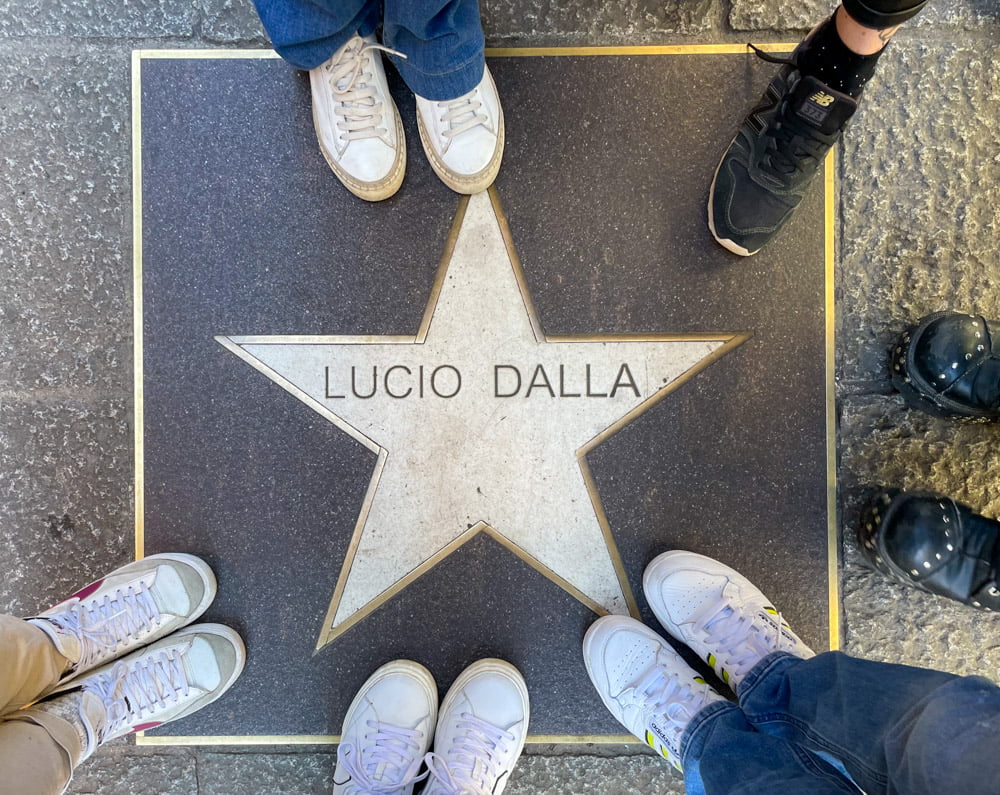
Lucio Dalla’s house
In addition to jazz, Bologna boasts a great musical tradition. Numerous singer-songwriters and artists originate from the capital of Emilia. Lucio Dalla is undoubtedly one of the most representative singer-songwriters. Many of his songs reflect his strong connection with Bologna, his hometown.
As you walk through the city, you can picture the places that he describes in his lyrics, such as the renowned Piazza Grande, which is also known as Piazza Cavour. Nowadays, his apartment located in Via d’Azeglio, which occupies the main floor of a building, serves as the headquarters of the Lucio Dalla Foundation.
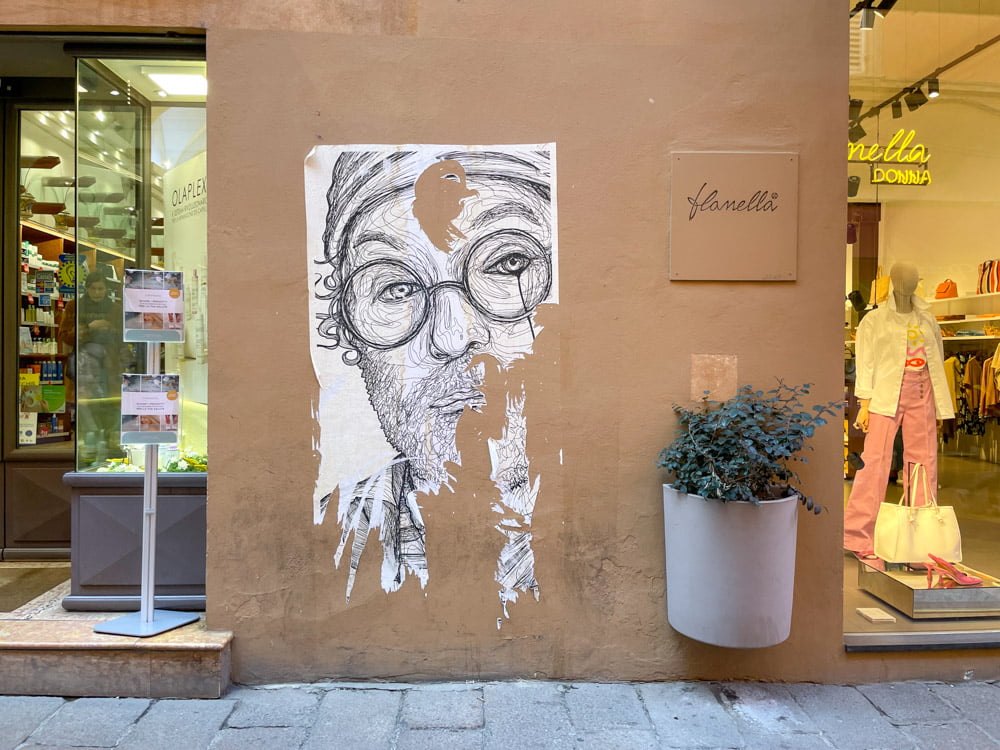
Via Piella’s little window
The Via Piella’s little window is one of the city’s most famous attractions. You’ll feel like you are in Venice because of the view of one of the few surviving medieval canals. Its peculiarity is the view of the Moline Canal, one of the few water stretches not covered with asphalt between the early 20th century and the post-war period. Bologna is not crossed by natural rivers but was built on artificial canals. In the Middle Ages, these canals were used to transport goods and people and to supply energy to the mills of the local textile industries.
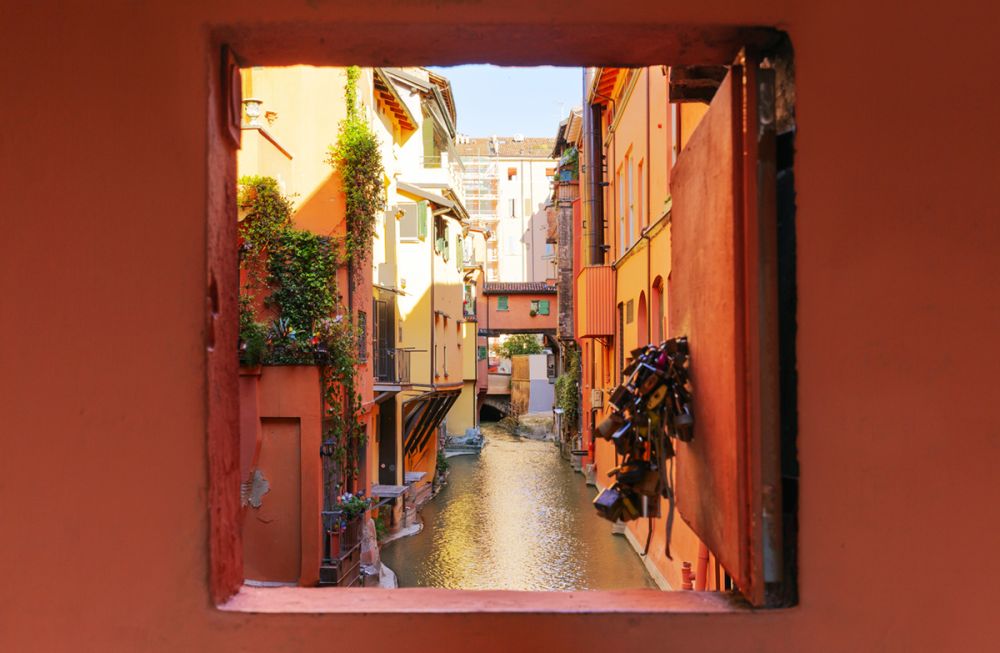
The Archigymnasium
The Archigymnasium is one of Bologna’s most characteristic buildings and housed the city’s ancient university. According to legend, Pope Pius IV built it to take funds away from the Basilica of St. Petronius and prevent it from exceeding the size of St. Peter’s in Rome. The Archigymnasium’s construction occupied a space intended for the Basilica, effectively limiting the size of the church. One of the architectural highlights is the magnificently decorated square courtyard with a double loggia.
Inside the palace, the Anatomical Theatre is named after its amphitheatre shape and used for studying human anatomy. In this room, you can see a copy of the marble table where autopsies were performed, surrounded by the students’ benches. So that you know, the Archigymnasium is only open during the week.
The best panoramic viewpoints in Bologna
Bologna is a city famous for its beauty and viewpoints. These include the UNESCO World Heritage-listed porticoes of St. Luke, which lead to the Sanctuary of the same name. The dome of the Sanctuary of the Blessed Virgin of Saint Luke is another of Bologna’s must-see scenic viewpoint, with a panoramic view of the hills of Bologna. At the same time, from the Asinelli Tower, you can see the city from above.
The porticoes of Bologna
A unique feature of Bologna is its 40-kilometre-long porticoes, a UNESCO World Heritage Site. The porticos in the city are distinguished by their architectural style. You can admire the medieval ones of Casa Isolani in Strada Maggiore or the Renaissance ones of the Basilica di St. Giacomo Maggiore in Via Zamboni, to name but a few.
The Portico of St. Luke, which connects the centre of Bologna to the Sanctuary of the Blessed Virgin of Saint Luke, is the longest in the world, with 3,796 metres and 666 arches. According to legend, the number of arches represents the devil as a snake whose head is crushed by the Virgin of the Sanctuary. The view from St Luke’s porticoes is genuinely panoramic, and the arcade accompanies you from the city centre to the top of the Colle della Guardia.
Curiously, the porticoes in Bologna were not built, as in many other cities, to protect against the weather, but to enlarge the houses. This system was used to increase the number of accommodations for students arriving in the capital of Emilia to attend university.
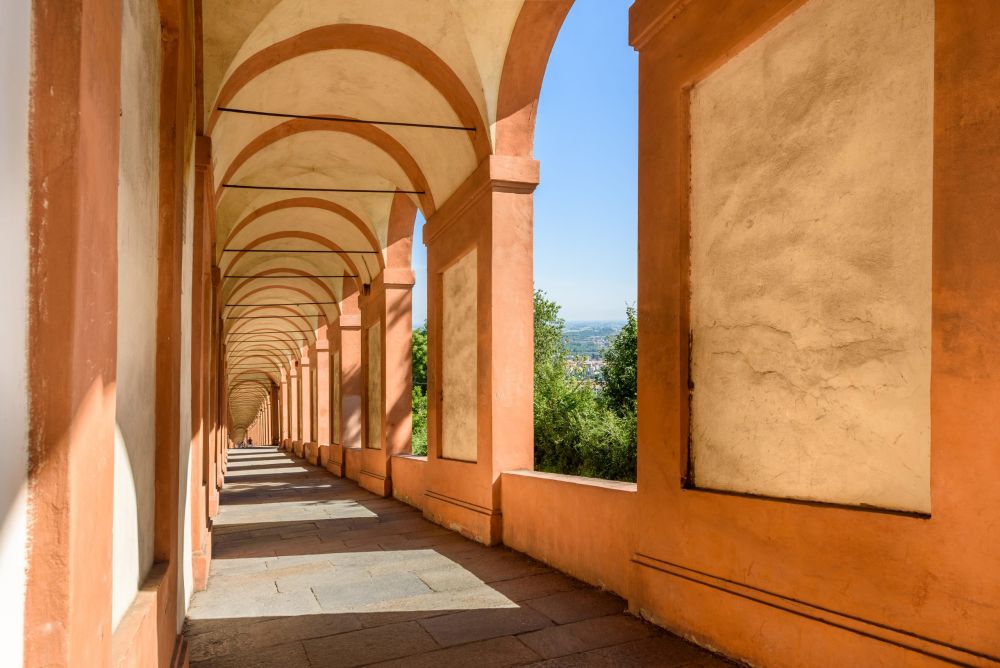
The Sanctuary of the Blessed Virgin of Saint Luke
During my visit to Bologna, I also visited the Sanctuary of the Blessed Virgin of Saint Luke, located on top of the Colle della Guardia. Its panoramic dome offers an incredible view of the hills of Bologna. The tradition is to reach the Basilica exclusively on foot to ask for the intercession of the Virgin Mary of St Luke. Some do it to get a promotion or to pass the last university exam before graduating.
You can reach the Sanctuary of the Blessed Virgin of Saint Luke, a UNESCO World Heritage Site, through the longest portico in Bologna. It stretches almost 4 kilometres, and it is the longest covered entrance in the world. However, you can also reach the Sanctuary by the little train St Luke Express, from Piazza Maggiore, saving time and effort.
From a religious point of view, the Sanctuary of the Blessed Virgin of Saint Luke is very important to the faithful because there is an icon of the Blessed Virgin inside. According to the legend, the Santurary was built by the evangelist Luke who brought the icon to Bologna from the Basilica of St Sophia in Constantinople.
If, on the other hand, you are simply in search of breathtaking views, you can enjoy a spectacular view of the hills of Bologna from the balcony located on the dome of the Sanctuary of the Blessed Virgin of Saint Luke. When there is no mist, you can even admire the peaks of the Apennines that mark the border between Emilia Romagna and Tuscany.
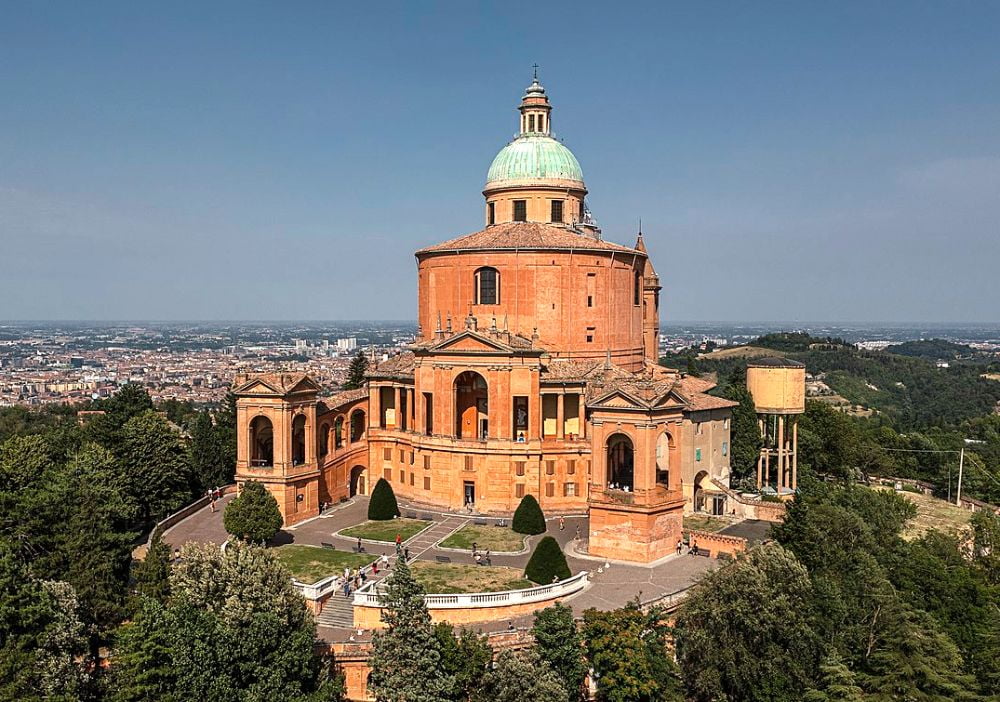
The two towers of Bologna: the Asinelli Tower and the Garisenda Tower
Another architectural feature of Bologna is its towers, built in the Middle Ages to symbolise family power and wealth. Although over a hundred were built, only about twenty remain today. Among the most famous towers are the Garisenda Tower and the Asinelli Tower, named after two ancient Bolognese families.
Both towers are located in Piazza di Porta Ravegnana, but the Asinelli Tower is undoubtedly the most imposing, standing an impressive 97 metres high. You can climb to the top of the tower via a staircase of 498 steps, and the panoramic view of the city is an unforgettable experience.
The Garisenda Tower, on the other hand, is only 48 metres high and is inclined due to the subsidence of the ground. Built in the 12th century, it was once connected to the Asinelli Tower by a bridge. Despite its slope, the tower is still an impressive and fascinating sight.
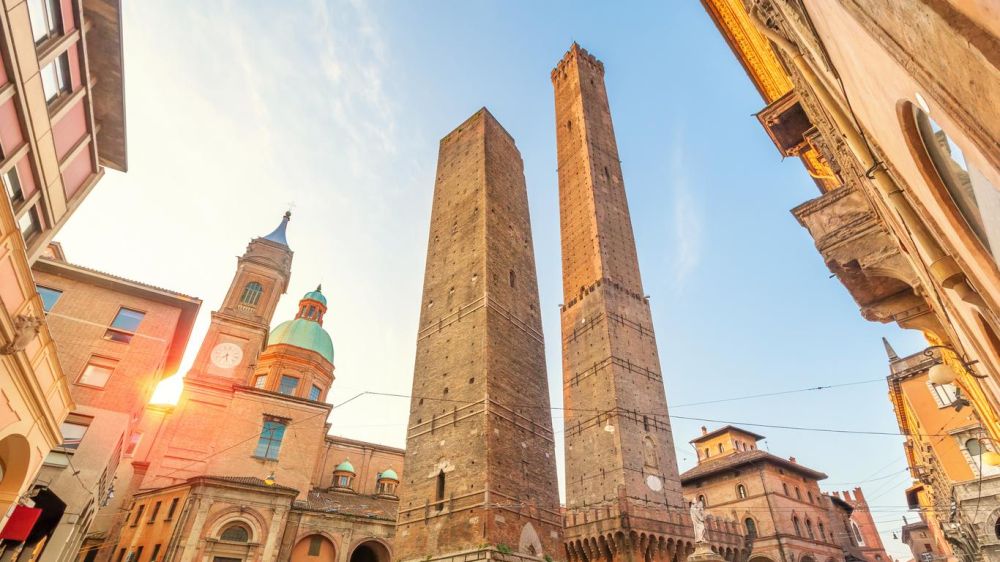
Tips for visiting Bologna
If you want to visit Bologna for the first time and discover all its curiosities, I recommend taking a walking tour of the historic centre. This way, you can find many curiosities about the city, such as the measurements in Piazza Maggiore or the stone of shame, from which you can admire the Neptune Fountain from an unusual perspective.
If you only have one day to visit Bologna and are not discouraged by the idea of walking so much, you can see all the attractions I have included in this article, at least from the outside. However, I recommend you take the little train to reach the Sanctuary of the Blessed Virgin of Saint Luke, as it takes half a day to get there on foot.
Alternatively, you can visit Bologna with the panoramic tourist bus, an excellent solution to introduce a city’s history and culture when you need more time. Of course, to see all of Bologna in-depth, you would need several days, but this itinerary can already give you a good perspective on the capital of Emilia.
Finally, you cannot leave Bologna without trying its gastronomic specialities, such as tortellini in brodo or tagliatelle al ragù, which are truly delicious. I suggest you stop at one of the city’s excellent trattorias to taste these typical dishes.
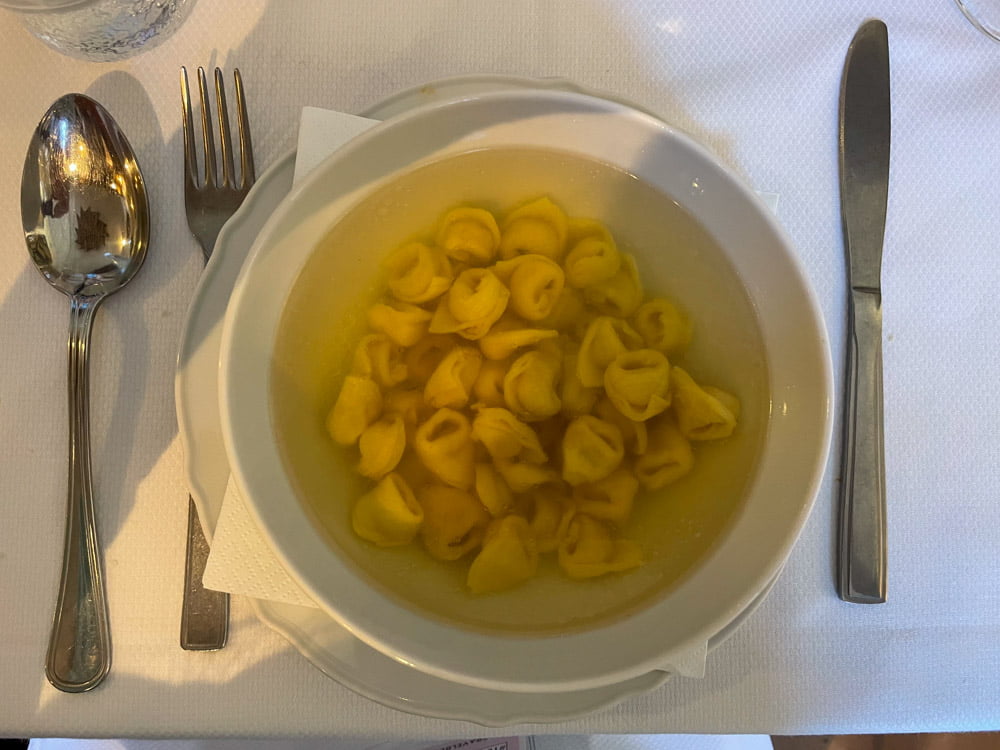
How to get to Bologna
Bologna is easily accessible by car and train, well connected to major Italian cities. Using a car, the A1, A14, and A13 motorways connect Bologna with essential locations such as Milan, Florence, Rome, Venice, Padua, Rimini and Ravenna. In contrast, the S64 connects Bologna directly with Ferrara. In the city centre, there are several pay car parks where you can leave your car. If you arrive in Italy by plane, renting a car at the airport can be an option, especially if you’d like to discover the towns around.
However, the best, cheapest and most ecological way to reach Bologna is by train. The Bologna Centrale railway station is one of Italy’s main railway hubs, with regular Italo or Trenitalia high-speed, Intercity and regional trains. Once at the station, you can reach the city centre on foot or by bus in ten minutes.
With the Frecciarossa one-day round-trip offers, you can see Bologna in a day and spend very little. I did so with a direct train to and from Turin, buying a return ticket for around €50. Search Trainline yourself to compare all Italo and Trenitalia offers in one place.
You can visit Bologna in just one day to discover a city rich in art, culture, and great food. I highly recommend taking a guided tour to see the main attractions, such as Piazza Maggiore, the Neptune Fountain, and the Sanctuary of the Blessed Virgin of Saint Luke. If you love food, don’t miss the chance to taste some local culinary specialities like tortellini in brodo or tagliatelle al ragù. Don’t forget to leave a comment about your experience in Bologna.
